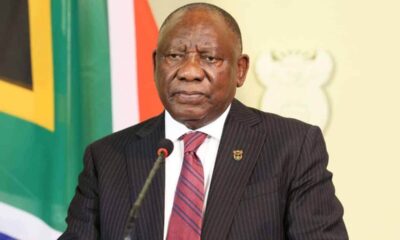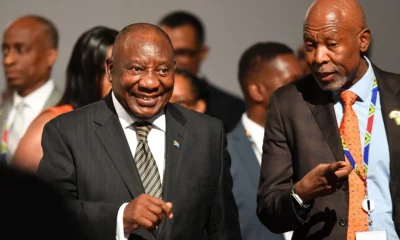News
South Africans Brace for Possible Rate Cut as New Inflation Target Sparks Fresh Optimism

A New Mood of Hope And a Possible Rate Cut
After two years of punishing borrowing costs, South Africans might finally be inching toward relief.
With the National Treasury officially adopting a 3% inflation target, economists say the stars are beginning to align for a 25 basis point rate cut from the Reserve Bank as early as this week.
It’s the first time in a long time that households, investors and lenders are reading the same signals: the country is slowly shifting toward a lower, more predictable inflation path and that opens the door to cheaper credit.
“This is a big deal,” many analysts echoed online, with social media buzzing about whether bond repayments might finally start shrinking.
A Target That Changes the Tone of Policy
For years, Treasury and the Reserve Bank have worked toward policy alignment, but adopting the 3% target with a one-percentage-point flexibility band marks the most concrete step toward that coordination.
Investec Treasury Economist Tertia Jacobs explains that the move essentially rewrites the assumptions that shape government spending.
Social grants, wage increases and other indexed expenditure will now be guided by a lower inflation baseline. In plain language: government is trying to enforce fiscal discipline while nudging the economy toward long-term price stability.
Jacobs says this gives the Reserve Bank a stronger foundation to eventually bring interest rates down once inflation consistently settles around that target.
But the Big Question Everyone’s Asking Is: Will the Cut Happen Now?
The National Treasury says the new target will be rolled out over the next two years, a timeline that intriguingly matches the Reserve Bank’s own inflation-stabilisation estimates.
Still, economists are divided over the timing.
Where the experts stand
-
Investec: Expects a unanimous vote for a 25 bps cut this week.
-
Markets: Pricing in an 80% probability of a rate cut.
-
Nedbank: Recently shifted from expecting a “hold” to forecasting a 25 bps cut.
But there’s a twist.
The US factor
Investec Chief Economist Annabel Bishop warns the SARB may hesitate, simply because the US has not cut interest rates again this year.
International policy moves matter and with the US government’s temporary shutdown delaying key economic data releases, global uncertainty is still clouding the picture.
Even though Washington has reopened, investors are still waiting for missing data to be published. If those numbers arrive too late, SARB may adopt a conservative stance.
Inflation: Still Behaving… But Not Quite There Yet
This week’s inflation data is another wildcard.
-
September CPI: 3.4%
-
Expected October CPI: 3.6%
-
August CPI: 3.3%
Inflation has been lower than forecast, which ordinarily strengthens the case for a rate cut.
But the Reserve Bank nudged its inflation expectations slightly higher in September, from 3.4% to 3.6% for this year, and 3.6% again for next year.
Bishop believes 2025 will still average around 3.2%, comfortably within the new target range. But Nedbank economists caution that inflation is “drifting slightly upward,” even if underlying price pressures remain contained.
Why a Rate Cut Is Still on the Table
Economists argue that despite the small uptick in inflation, the wider picture leans toward relief:
-
Domestic price pressures are mild.
-
Global disinflation is accelerating.
-
The economy is losing momentum desperately.
Nedbank’s latest view is that policy is simply too restrictive for an economy “lacking meaningful growth.” With that in mind, the bank now supports a cut as a move toward a more “neutral” interest rate stance.
Even with a cut, Nedbank warns that the real policy rate will remain high, still hovering just above 3% by year-end.
This aligns with the Reserve Bank’s own projection model released in September which hinted at one more 25 bps cut before the year wraps up.
A Fresh Angle: Why This Week Matters More Than Usual
The timing of this decision is symbolically important.
South Africa has just signalled to the world that it is serious about structural reform, especially after years of fiscal strain, political uncertainty and rising living costs.
A rate cut now would telegraph confidence in the country’s economic direction.
On social media, South Africans have been both hopeful and sceptical:
-
“I’ll only believe it when my bond repayment drops.”
-
“Nice to see Treasury and SARB finally speaking the same language.”
-
“We deserve some good news for once.”
The public mood is clear: people are exhausted, financially strained and desperate for relief.
What Happens Next?
The Monetary Policy Committee sits this week and their decision could shape how the country enters 2026.
If the cut comes:
-
Bond and loan repayments may ease slightly.
-
Business confidence could finally lift.
-
Consumers may feel the first hint of breathing room in years.
If it doesn’t:
-
Economists will blame global uncertainty.
-
Households will brace for continued pressure.
-
All eyes will shift to early 2026 for the next move.
Either way, the new 3% inflation target has already changed the country’s economic conversation.
South Africa is planning for a more stable future and this week could mark the first step toward it.
{Source: Business Tech}
Follow Joburg ETC on Facebook, Twitter , TikTok and Instagram
For more News in Johannesburg, visit joburgetc.com



























